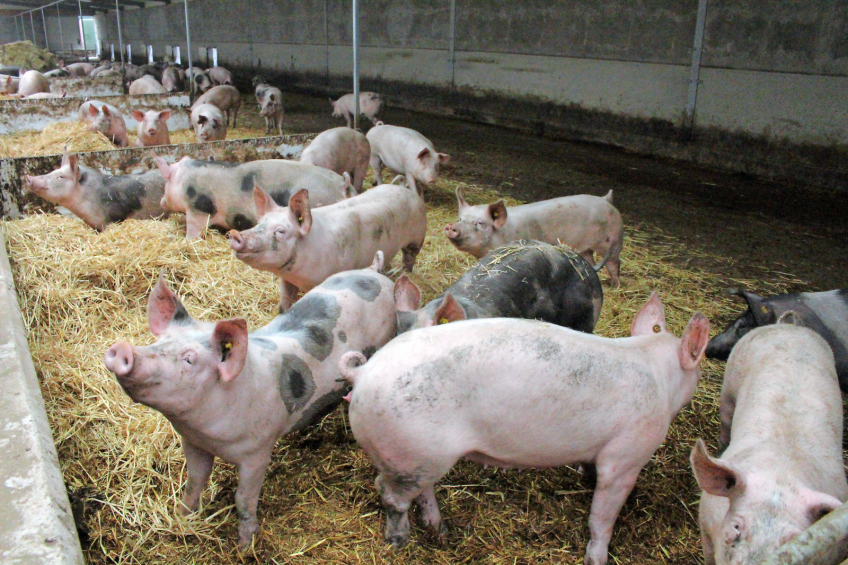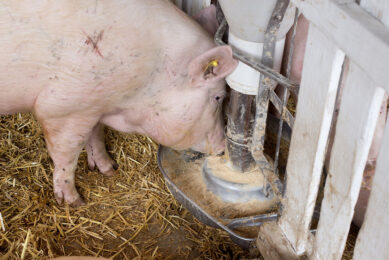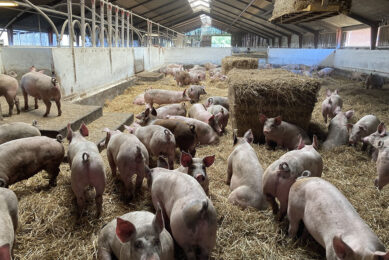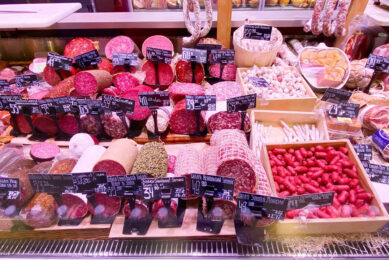Happy pigs at an ultra-modern organic farm

Can pigs actually be happy? At the modern, well equipped organic pig farm ‘Ekovar Wennekers’ near Schagen in the Netherlands, the pigs are as close to happy as they can get, with space to stretch their legs, straw to dive into and piles of silage to chew away on.
A huge pile of silage is definitely something to the pigs’ liking. In groups they stand around it and start chewing, playing, pushing – unaware of penmates on the other side of the pile becoming a victim of a silage avalanche. Pig farmer Jan Wennekers, 38, gazes at the porcine entertainment and explains, “I add a pile of silage roughly once every 2 days. The pigs really love it – and it smells good too. I’d even try it myself!”
Organic pig farming is much more than allowing pigs to run into meadows, so much becomes clear at Ekovar Wennekers, where high-welfare pig production is combined with the latest techniques, insights and management systems. The farm, owned by Jan and Francisca Wennekers as well as Jan’s parents, is located near Schagen, about 60 km north of Amsterdam, the Netherlands. In early 2016, the farm added four finishing barns for 360 finishers each. The back sides of the pig houses are made of earth, so from a distance they appear to be Dutch-style ‘dykes’. That way the farm blends into the landscape. In total, the farm now houses 190 sows and finishes every pig on-farm.
Ekover produces organically
Organic pig farming in the Netherlands, what does that mean? It comes with a labelling system in supermarkets, certified by the Dierenbescherming – an animal welfare organisation that actively seeks cooperation to improve animal welfare. Participating products in retail shops get a special ‘Beter Leven’ (Better Life) label, with 1, 2 or 3 stars, depending on the quality of life an animal had during its life. This label applies to pig, poultry, beef and egg industries.
As Ekovar produces organically, pork from this farm is sold with the maximum of 3-stars. This equals for instance to ample space for all animals, weaning at at least 42 days, enormous amounts of straw used on the farm, no tail docking and possibilities to go outdoors for all pigs on-farm.
Pioneers in organic pig farming
The Wennekers family were pioneers when it comes to organic pig farming in the Netherlands. Jan Wennekers’ father already switched to organic in 1986. He says, “We tried to farm in a conventional way, but to see the pigs locked up, that didn’t feel good to any of us. So we decided to go organic. At the time they were one of three, nowadays we are with many, around 90 in the Netherlands alone.”
The meat gets all sold to the ‘De Groene Weg’ (The Green Way), a sales channel for organic-only meat products and owned by Vion Food, the Netherlands’ largest meatpacker for pork products. Jan Wennekers explains, “That means that various groups and institutions will come and inspect whether the farm still meets all organic guidelines. Often there is an announced and an unannounced visit every year.”
In terms of profit, it pays to grow pigs entirely organically. Wennekers gets on average about €3.40/kg per finished pig of roughly 95 kg slaughter weight (115-120 kg live weight). Compare that to a conventional pig rewarding about €150 on the market. Wennekers adds, “Please do keep in mind that the feed is also twice as expensive!”
Farm set-up
As in conventional pig farms, the pigs can be found in 4 different sections.
Gestating area
The gestating area is one wide area covered with straw and separated places to lie. In winter the sows can go outside in an area with slatted floor; in summer, they have access to a long meadow with a pool. The sows are fed using Electronic Sow Feeding stations by Nedap, followed by sorting stations.
Lactating area
There are 60 farrowing pens, sized 2.25 x 3.00 m, which is wider than what most conventional organic farms offer – plus each pen has a private outdoor area. The farm chooses to apply freedom farrowing, although there are crates in each farrowing pen, for confinement during the first 3 days when necessary. Sows get vaccinated for parvovirus and PRRS. The piglets get 2 types of treatments: iron after 3 to 7 days; and the males also receive anaesthetics and painkillers during and after castration. Castration is allowed, as otherwise the meat cannot be sold abroad.
The farrowing pens have a closed straw section and a slatted section. Wennekers explains that there’s only a small manure gutter underneath that can be scraped out easily, so there’s no reason to fear straw clogging the manure system.
The piglets stay with their mothers until they are 6 weeks (42 days), then the sows are moved away and the piglets move into the weaner section 2 weeks later.

Weaner section
Weaners are in the old finisher houses. There is space for roughly 700 of them in spacious pens with straw and an outside area for about 20 animals each. They are in there from around 15-20 kg until 30-40 kg, for roughly 10-12 weeks.

Finishers
The finishers, in the 4 new sections, have a huge space at their disposal for 350 animals – partly inside and partly outside. They are all fed through Nedap sorting stations, with 2 different rations, one for lower than 50 kg and one for bigger than 50 kg. A weighing station will tell whether to go left or right. Using transponders, the machine can also estimate about 4 weeks in advance how many pigs will be ready for slaughter. The pigs are ready for slaughter at 115-120 kg in 6 to 7 months.
As the feed bins are located outside, they are covered with flaps, so that only when a pig pushes with some force it opens. That way sparrows, keen to get some of the feed as well, will not have access.

The finisher pigs receive compound feed, containing grains, lupins and soybeans and produced by compound feed producer Agrifirm. In addition, Wennekers provides much straw and silage, as stated above.
Where the feeding stations outside are covered by a roof – the remainder is not. Only a sprinkler installation can offer ‘rain’, which pigs enjoy on warm days. As a result, relatively much rain and water leaks through the slats, diluting the manure slightly.
Manure management
Since the Netherlands is a densely populated country, usually pig farmers have to pay to get rid of their manure. Not so for Ekovar Wennekers, his can be distributed against no extra cost – as there is a shortage of organic manure in the Netherlands. It is collected from large underground tanks and sold on to organic feed growers – material that comes back in the feed at the farm again. Wennekers says, “And that is how we make the circle closed again.”
Ekovar, Schagen, the Netherlands
Ekovar is a closed, organic farrow-to-finish facility; the only element ever arriving is pig semen. The farm recently expanded to 190 sows. All pigs have ample space and can go outside. The farm only applies antibiotics to individual animals for treatment purposes. The farm is owned by a family consisting of four people – two do the work in the barns. The farm uses a Topigs 20 sow and new sire lines by Topigs. Wennekers is at 25 pigs/sow/year. The farm receives subsidies for its role in wildlife bird management on its 27 ha estate.
 Beheer
Beheer









 WP Admin
WP Admin  Bewerk bericht
Bewerk bericht